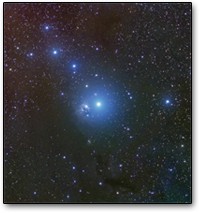Written in the Stars

By Ashley Peterson
ConstellationsAutumn is a great time for stargazing; the nights are clear, longer than summer’s, and the temperatures dip just enough to increase atmospheric seeing. If you live in the Northern Hemisphere, several constellations should be visible during the fall months. Constellations are formations of bright stars that appear close to each other in the night sky. The shapes they form depend on your point of view, but civilizations and cultures throughout history have created their own patterns in the sky based on stories and people that were important to them.
Cepheus and Cassiopeia
Looking North, the constellations Cepheus and Cassiopeia are named after the King and Queen of Ethiopia in Greek mythology and appear side by side in the night sky. The stars of Cassiopeia, during the fall, form a letter “M” that represents her crown. Cepheus is shaped like a house, and because its stars are of lesser apparent magnitude than Cassiopeia, it can be difficult to see. However, this region of the sky is of particular interest to astronomers as it is full of double stars, binary systems in which one star orbits another, and contains three red supergiants, all found in our Milky Way Galaxy.
Andromeda and Cetus
Andromeda is a “V” shaped constellation named after the princess of the mythical kingdom of Ethiopia. According to Greek mythology, Andromeda’s mother, Queen Cassiopeia, bragged that she was prettier than the sea nymphs.
The nymphs complained to Poseidon, the god of the sea, who in turn sent the sea monster, Cetus, to destroy her land. The queen and her husband, King Cepheus, were forced to sacrifice their daughter Andromeda to save the country. Today, Cetus is also commonly referred to as “the whale” because of its shape in the sky. Due to its size, there are only a few months of the year, in autumn, when the entire constellation is visible.
Perseus
Perseus is a Greek hero, most famous for slaying Medusa. According to myth, anyone who laid eyes on Medusa’s face would turn to stone, but Perseus was able to defeat Medusa by hiding behind his shielding mirror. The legend says that on his way home, he came upon Cetus, and rescued Princess Andromeda
using the head of Medusa to turn the monster to stone. Perseus appears as a backwards “K” in the night sky. With some imagination, stargazers can make out the image of a man with two arms stretching out, possibly holding a weapon or the head of Medusa.
A Brilliant Story is in the Stars
You may not be able to spot all of these constellations right away, but with a little patience and the right conditions, the autumn sky has a story to tell. Grab a pair of binoculars, a cup of hot cocoa and enjoy the view!
Classroom Discussion
- Why are most constellations seasonal, only visible during certain months of the year?
- Can you name another constellation and explain how/why it is was named?
